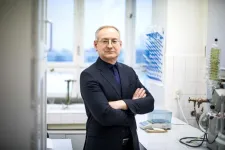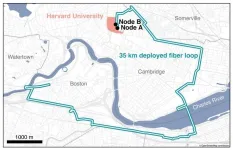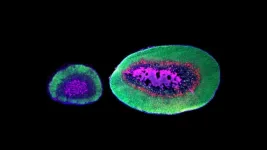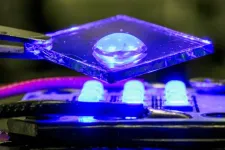(Press-News.org) Researchers from Kaunas University of Technology (KTU), Lithuania, who contributed to the development of record-breaking solar cells a few years ago, expanded their invention. The self-assembled monolayers can now be applied not only in inverted but also in regular structure perovskite solar cells.
Self-assembling molecules arrange themselves into a single-molecule-thick layer and in this case, they act as an electron-transporting layer in solar cells.
“The molecules that make up these monolayers, like a clever glue, coat the surface of the constructed devices with a thin one molecule thick layer. And this is not random, they don't stick wherever they go, but attach themselves by chemical bonds only where they are in contact with conductive metal oxide,” explains Tadas Malinauskas, Professor at KTU’s Faculty of Chemical Technology and one of the inventors of the new technology.
According to Malinauskas, the development of such a layer is a relatively simple and material-efficient process that requires a glass substrate with an electrically conductive metal oxide layer to be immersed in or sprayed with a highly diluted solution of the compound.
In this way, the self-assembling molecules are only attached to the surface of the metal oxide, and those that do not stick are washed away. This way a thin layer is created only where it is needed.
A crucial step in the development of the next generation solar cells
A team of KTU researchers has been synthesising and studying charge-transporting organic materials for several years. Previous experiments have focused more on molecules used for positive charge transfer in the perovskite solar cells.
“We can already say with confidence that these molecules have given a major boost to the development of the next generation solar cells. So, our next step is quite logical: to develop analogous molecules that can carry negative charges, and to apply these materials in perovskite solar cells,” says Vytautas Getautis, professor at the KTU Faculty of Chemical Technology and Head of the research group in charge of invention.
Although it is a very thin layer, the role it plays in solar cells is extremely important. Malinauskas says that the best analogy for its function is the subway. “This layer, like an automatic gate on the subway, allows only one type of charge to pass through and continue its journey towards the electrode,” he says.
In this way, self-assembled molecules increase the efficiency of solar cells.
Perovskite solar cell structures differ in the sequence of layers. In the regular structure, a negative charge transporting layer is formed on a transparent substrate, followed by light-absorbing and positive charge transporting layers. In solar cells with an inverted structure, the positive and negative charge transport layers are swapped.
Inventor and KTU PhD student Lauryna Monika Svirskaitė says that the main difference between the two structures is the areas of their application.
“The regular structure is more widely used to study low-cost, easier-manufactured but less efficient solar cells. The inverted architecture allows them to be used in the construction of much more efficient combined devices, also known as tandem devices,” says Svirskaitė.
At the moment, as both structures are being intensively researched, the KTU scientists believe that the new invention is just as significant and promising as the last one.
The strongest inventions in the KTU patent portfolio
The new invention is the result of a collaboration with scientists from King Abdullah University of Science and Technology (KAUST).
“We, KTU chemists, were responsible for the development, improvement, and optimisation of the materials and coating technology, while our colleagues from Saudi Arabia investigated the performance of it in solar cells,” reveals Malinauskas.
Greta Žėkienė, Head of Intellectual Property Management at KTU’s National Innovation and Entrepreneurship Centre (NIEC), says that the demand for this invention is surprisingly high. In this case, interest in the invention’s industrial use preceded the filing of the patent application.
According to Žėkienė, the search for partners usually starts after a patent application is filed, and most of the time an invention receives attention only after the publication of a scientific article is released.
“A Japanese company, with whom we already have several licences for inventions in this field, immediately expressed the interest to have the innovation in their product portfolio. They were waiting for us to prepare a patent application. The process of negotiating a licence agreement started right away,” says Žėkienė.
She emphasises that it is not necessary to obtain a patent for the commercialisation of an invention. While it depends on the individual case, commercialisation of an invention can take place at any time if a business declares its intention to license or take over all the property rights.
The Head of Intellectual Property Management at KTU says that inventions in the field of solar cells made by the Synthesis of Organic Semiconductors research group are the strongest in KTU’s patent portfolio and receive a lot of interest from businesses in this field. “We feel proud and acknowledged when companies want to start using the inventions as soon as possible,” adds Žėkienė.
The article Nonfullerene Self-Assembled Monolayers As Electron-Selective Contacts for n-i-p Perovskite Solar Cells was published in ACS Energy Letters 2024 and can be accessed here.
END
Lithuanian researchers’ new development in solar cell technology – a promise of a significant advancement in the field
Researchers from Kaunas University of Technology (KTU), Lithuania, who contributed to the development of record-breaking solar cells a few years ago, expanded their invention.
2024-05-15
ELSE PRESS RELEASES FROM THIS DATE:
A simple internet with significant possibilities
2024-05-15
It’s one thing to dream up a quantum internet that could send hacker-proof information around the world via photons superimposed in different quantum states. It’s quite another to physically show it’s possible.
That’s exactly what Harvard physicists have done, using existing Boston-area telecommunication fiber, in a demonstration of the world’s longest fiber distance between two quantum memory nodes to date. Think of it as a simple, closed internet between point A and B, carrying a signal encoded not by classical ...
Unwrapping the origin story of the baobab
2024-05-15
The baobab (Adansonia) is a genus of trees with eight extant (in existence currently) species and a long history of humans marveling at them. For as much admiration the baobabs get, there is an equal amount of mystery surrounding their origin.
Genomic and ecological analyses recently done by a global research team led by Sino-Africa Joint Research Center, CAS (hosted by Wuhan Botanical Garden of the Chinese Academy of Sciences), suggest that Madagascar, is the origin from where all other baobab species hail. With a deeper understanding of the baobabs' genetics, researchers are hoping to uncover some clues on what ...
The origin and long-distance travels of upside down trees
2024-05-15
The iconic baobabs, also known as upside-down trees, or the tree of life, have much cultural significance, inspiring innumerable arts, folklore, and traditions. A research published in Nature, involving international collaboration between Wuhan Botanical Garden (China), Royal Botanic Gardens (Kew, UK), University of Antananarivo (Madagascar) and Queen Mary University of London (UK) reveal a remarkable example of species radiation in Madagascar followed by long distance dispersal to Africa and Australia. With speciation, an astonishing divergence of pollination mechanisms evolved, that exploit hawkmoths, bats and lemurs for ...
Some mice may owe their monogamy to a newly evolved type of cell
2024-05-15
NEW YORK, NY — What makes the oldfield mouse steadfastly monogamous throughout its life while its closest rodent relatives are promiscuous? The answer may be a previously unknown hormone-generating cell, according to a new study published online today in Nature from scientists at Columbia's Zuckerman Institute.
"The hormone from these cells was actually first discovered in humans many decades ago, but nobody really knew what it did," said Andrés Bendesky, MD, PhD, a principal investigator at Columbia's Zuckerman Institute. "We’ve discovered ...
Mortality in patients hospitalized for COVID-19 vs influenza in fall-winter 2023-2024
2024-05-15
About The Study: This study found that in fall-winter 2023-2024, the risk of death in patients hospitalized for COVID-19 was greater than the risk of death in patients hospitalized for seasonal influenza.
Corresponding Author: To contact the corresponding author, Ziyad Al-Aly, M.D., email ziyad.alaly@va.gov.
To access the embargoed study: Visit our For The Media website at this link https://media.jamanetwork.com/
(doi:10.1001/jama.2024.7395)
Editor’s Note: Please see the article for additional information, including other authors, author contributions and affiliations, conflict of interest and financial disclosures, and funding and support.
# # ...
First ‘warm-blooded’ dinosaurs may have emerged 180 million years ago
2024-05-15
The ability to regulate body temperature, a trait all mammals and birds have today, may have evolved among some dinosaurs early in the Jurassic period about 180 million years ago, suggests a new study led by UCL and University of Vigo researchers.
In the early 20th century, dinosaurs were considered slow-moving, “cold-blooded” animals like modern-day reptiles, relying on heat from the sun to regulate their temperature. Newer discoveries indicate some dinosaur types were likely capable of generating their own body heat but when this adaptation occurred is unknown.
The new study, published in the journal Current Biology, looked at ...
Next-generation sustainable electronics are doped with air
2024-05-15
Semiconductors are the foundation of all modern electronics. Now, researchers at Linköping University, Sweden, have developed a new method where organic semiconductors can become more conductive with the help of air as a dopant. The study, published in the journal Nature, is a significant step towards future cheap and sustainable organic semiconductors.
“We believe this method could significantly influence the way we dope organic semiconductors. All components are affordable, easily accessible, and potentially environmentally friendly, which is a prerequisite for future sustainable ...
Disparities in patient portal engagement among patients with hypertension treated in primary care
2024-05-15
About The Study: This cohort study of patients with hypertension found clear sociodemographic disparities in patient portal engagement among those treated in primary care. Without special efforts to engage patients with portals, interventions that use patient portals to target hypertension may exacerbate disparities.
Corresponding Author: To contact the corresponding author, Rasha Khatib, Ph.D., M.H.S., email rasha.alkhatib@aah.org.
To access the embargoed study: Visit our For The Media website at this link https://media.jamanetwork.com/
(doi:10.1001/jamanetworkopen.2024.11649)
Editor’s Note: Please see ...
Dose-dependent association between body mass index and mental health and changes over time
2024-05-15
About The Study: This study revealed a U-shaped association between adolescent body mass index and mental health, which was consistent across sex and grades and became stronger over time. These insights emphasize the need for targeted interventions addressing body image and mental health, and call for further research into underlying mechanisms.
Corresponding Author: To contact the corresponding author, Shanquan Chen, Ph.D., email Shanquan.chen@lshtm.ac.uk.
To access the embargoed study: Visit our For The Media website at this link https://media.jamanetwork.com/
(10.1001/jamapsychiatry.2024.0921)
Editor’s ...
The doctor is in…. but what’s behind them?
2024-05-15
Americans have gotten used to seeing their doctors and other health care providers using telehealth video visits in the past four years. But a new study reveals that what a doctor has behind them during a telehealth visit can make a difference in how the patient feels about them and their care.
Even if the doctor is miles away from their usual in-person clinic or exam room, they should make it look like they’re there, the study suggests.
Even better: sitting in an office with their diplomas hanging ...
LAST 30 PRESS RELEASES:
The vast majority of US rivers lack any protections from human activities, new research finds
Ultrasound-responsive in situ antigen "nanocatchers" open a new paradigm for personalized tumor immunotherapy
Environmental “superbugs” in our rivers and soils: new one health review warns of growing antimicrobial resistance crisis
Triple threat in greenhouse farming: how heavy metals, microplastics, and antibiotic resistance genes unite to challenge sustainable food production
Earthworms turn manure into a powerful tool against antibiotic resistance
AI turns water into an early warning network for hidden biological pollutants
Hidden hotspots on “green” plastics: biodegradable and conventional plastics shape very different antibiotic resistance risks in river microbiomes
Engineered biochar enzyme system clears toxic phenolic acids and restores pepper seed germination in continuous cropping soils
Retail therapy fail? Online shopping linked to stress, says study
How well-meaning allies can increase stress for marginalized people
Commercially viable biomanufacturing: designer yeast turns sugar into lucrative chemical 3-HP
Control valve discovered in gut’s plumbing system
George Mason University leads phase 2 clinical trial for pill to help maintain weight loss after GLP-1s
Hop to it: research from Shedd Aquarium tracks conch movement to set new conservation guidance
Weight loss drugs and bariatric surgery improve the body’s fat ‘balance:’ study
The Age of Fishes began with mass death
TB harnesses part of immune defense system to cause infection
Important new source of oxidation in the atmosphere found
A tug-of-war explains a decades-old question about how bacteria swim
Strengthened immune defense against cancer
Engineering the development of the pancreas
The Journal of Nuclear Medicine ahead-of-print tip sheet: Jan. 9, 2026
Mount Sinai researchers help create largest immune cell atlas of bone marrow in multiple myeloma patients
Why it is so hard to get started on an unpleasant task: Scientists identify a “motivation brake”
Body composition changes after bariatric surgery or treatment with GLP-1 receptor agonists
Targeted regulation of abortion providers laws and pregnancies conceived through fertility treatment
Press registration is now open for the 2026 ACMG Annual Clinical Genetics Meeting
Understanding sex-based differences and the role of bone morphogenetic protein signaling in Alzheimer’s disease
Breakthrough in thin-film electrolytes pushes solid oxide fuel cells forward
Clues from the past reveal the West Antarctic Ice Sheet’s vulnerability to warming
[Press-News.org] Lithuanian researchers’ new development in solar cell technology – a promise of a significant advancement in the fieldResearchers from Kaunas University of Technology (KTU), Lithuania, who contributed to the development of record-breaking solar cells a few years ago, expanded their invention.







